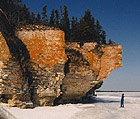 |
|||
|
|||
|
Copyright Editor's Notebook BY DIRK SCHMID
Introducing NunavutIn this issue of the Canadian Rockhound, Nunavut Territory is featured for the first time. John Thomas from Iqaluit reports on the creation of the Iqaluit Rockhound Association this past year, and on some of the activities undertaken by this new organization. David Scott provides an interesting summary on Nunavut's geological history. This is followed by an article on some of the more well-known mineral localities in Nunavut. In the near future, we hope to publish more information on Nunavut in the Canadian Rockhound.
Manitoba: giant fossils and
|
||||||
 Sturgeon Gill Point. This shoreline is localited in Manitoba's lowlands region. Photo courtesy of Roger Turenne.
|
The lowlands are a natural treasure that are in need of protection. In 1993, I visited the region while doing field work for the Manitoba Museum of Man and Nature. It was here that Kim Monson and Jack Dubois introduced me to the underground karst caves. These caves are home for the insect-eating Little Brown bats. The lowlands also contain interesting geological features, such as the cliffs at Sturgeon Gill Point. It is hoped that the lowlands will be protected as part of Canada's natural heritage for all to enjoy.
Acknowledgements:
I wish to thank all authors who contributed material for this issue. I am especially grateful to John Thomas and David Scott of the Canada-Nunavut Geoscience Centre for their contributions to the Nunavut feature. Doug Miller is thanked for providing mineral specimen photographs for the article on Nunavut mineral localities. I am grateful to Roger Turenne for supplying beautiful photographs for the article on the Manitoba lowlands. The Canadian Nature Federation and the Manitoba Museum of Man and Nature are also acknowledged for their cooperation and contributions.
As always, I welcome your comments, feedback and contributions. I hope you enjoy this delightful fifth anniversary issue.
Dirk Schmid, Editor
![]()
Copyright © 2001 Canadian Rockhound
E-mail
Document Number: CR0105100


Copyright © 2001 Canadian Rockhound
Website built by H. J. Schmid & Associates, Inc.
Winnipeg, Manitoba, Canada
Back Issues |
News & Events |
Junior Rockhound
Resources |
Clubs |
Dealers |
Web Links |
E-mail |
Home

